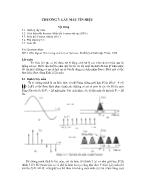 Kĩ thuật viễn thông - Chương 7: Lấy mẩu tín hiệu
Kĩ thuật viễn thông - Chương 7: Lấy mẩu tín hiệuTrong thí dụ 5.3, ta lấy mẩu tín hiệu f(t) bằng cách nhân tín hiệu này với chuỗi xung pT(t), và có được tín hiệu được lấy mẩu vẽ trong hình 5.8d. Phương pháp này được gọi là lấy mẩu tự nhiên. Hình P5.1-7 vẽ dạng lấy mẩu thường gọi là lấy mẩu dùng đỉnh phẳng (flat top sampling) của cùng tín hiệu f(t) = sinc2(5t). (a) Chứng tõ là có thể khôi phụ...
 37 trang | Chia sẻ: nguyenlam99 | Ngày: 22/01/2019 | Lượt xem: 673 | Lượt tải: 0
37 trang | Chia sẻ: nguyenlam99 | Ngày: 22/01/2019 | Lượt xem: 673 | Lượt tải: 0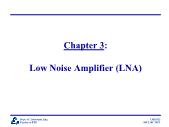 Kĩ thuật viễn thông - Chapter 3: Low noise amplifier (lna)
Kĩ thuật viễn thông - Chapter 3: Low noise amplifier (lna)An alternative design is based on the Gilbert cell multiplier in below figure, where The ratio of the diode equations with negligible saturation current gives a second relationship: Combining of these two equations gives an expression for IC1.
 73 trang | Chia sẻ: nguyenlam99 | Ngày: 22/01/2019 | Lượt xem: 733 | Lượt tải: 0
73 trang | Chia sẻ: nguyenlam99 | Ngày: 22/01/2019 | Lượt xem: 733 | Lượt tải: 0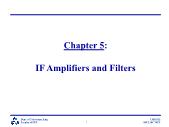 Kĩ thuật viễn thông - Chapter 5: If amplifiers and filters
Kĩ thuật viễn thông - Chapter 5: If amplifiers and filtersHybrid Methods: To meet various design goals, combinations of the above method may be employed: Several PLL synthesizers can be combined to create a multi-loop synthesizer. DDS and a PLL can be combined to achieve fine step sizes, yet the wide tuning range of a PLL
 65 trang | Chia sẻ: nguyenlam99 | Ngày: 22/01/2019 | Lượt xem: 766 | Lượt tải: 0
65 trang | Chia sẻ: nguyenlam99 | Ngày: 22/01/2019 | Lượt xem: 766 | Lượt tải: 0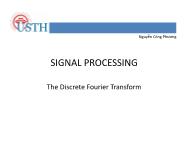 Signal processing - The discrete fourier transform
Signal processing - The discrete fourier transformComputational Fourier Analysis 2. The Discrete Fourier Transform 3. Sampling the Discrete – Time Fourier Transform 4. Properties of the Discrete Fourier Transform 5. Linear Convolution Using the DFT 6. Fourier Analysis of Signals Using the DFT 7. Direct Computation of the DFT 8. The FFT Idea Using a Matrix Approach 9. Decimation – in – Time...
 123 trang | Chia sẻ: nguyenlam99 | Ngày: 22/01/2019 | Lượt xem: 672 | Lượt tải: 0
123 trang | Chia sẻ: nguyenlam99 | Ngày: 22/01/2019 | Lượt xem: 672 | Lượt tải: 0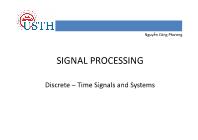 Signal processing - Discrete – Time signals and systems
Signal processing - Discrete – Time signals and systemsDiscrete – Time Signals Discrete – Time Systems Convolution Description of Linear Time – Invariant Systems Properties of Linear Time – Invariant Systems Analytic Evaluation of Convolution Numerical Computation of Convolution Real – Time Implementation of FIR Filters FIR Spatial Filters Systems Described by Linear Constant – Coefficient Di...
 74 trang | Chia sẻ: nguyenlam99 | Ngày: 22/01/2019 | Lượt xem: 682 | Lượt tải: 0
74 trang | Chia sẻ: nguyenlam99 | Ngày: 22/01/2019 | Lượt xem: 682 | Lượt tải: 0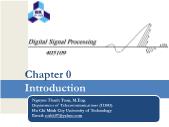 Digital Signal processing - Chapter 0: Introduction
Digital Signal processing - Chapter 0: IntroductionCho bộ lọc thông thấp có đáp ứng biên độ phẳng 0dB trong khoảng [0 4]KHz, suy giảm với độ dốc 12dB/octave trong khoảng [4 8]KHz và suy giảm với độ dốc 20dB/decade ngoài 8KHz. Tìm giá trị đáp ứng biên độ của bộ lọc tại các tần số sau: a) 2KHz. b) 3KHz. c) 5KHz. d) 6KHz. e) 7KHz. f) 8KHz. g) 10KHz. h) 12KHz. i) 16KHz. j) 20KHz
 51 trang | Chia sẻ: nguyenlam99 | Ngày: 22/01/2019 | Lượt xem: 731 | Lượt tải: 0
51 trang | Chia sẻ: nguyenlam99 | Ngày: 22/01/2019 | Lượt xem: 731 | Lượt tải: 0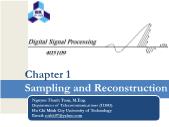 Digital Signal processing - Chapter 1: Sampling and reconstruction
Digital Signal processing - Chapter 1: Sampling and reconstructionCho tín hiệu ngõ vào tương tự x(t) = 1 – 2cos6t + 3sin14t (t: ms) đi qua hệ thống lấy mẫu và khôi phục lý tưởng với tần số lấy mẫu Fs = 8 KHz. a) Tìm giá trị mẫu x[n=2] của tín hiệu sau lấy mẫu? b) Xác định biểu thức (theo thời gian) của 1 tín hiệu chồng lấn (aliased signal) với tín hiệu ban đầu x(t)? c) Vẽ phổ biên độ của tín hiệu sau lấy m...
 45 trang | Chia sẻ: nguyenlam99 | Ngày: 22/01/2019 | Lượt xem: 1183 | Lượt tải: 0
45 trang | Chia sẻ: nguyenlam99 | Ngày: 22/01/2019 | Lượt xem: 1183 | Lượt tải: 0 Digital Signal processing - Chapter 2: Quantization
Digital Signal processing - Chapter 2: QuantizationMột tín hiệu rời rạc được lượng tử và mã hóa bằng bộ chuyển đổi A/D 4 bit có tầm toàn thang R=1@ V dùng giải thuật xấp xỉ liên tiếp làm tròn xuống (truncation). a) Hãy xác định khoảng lượng tử Q? b) Tìm giá trị lượng tử xQ cho giá trị rời rạc x=2.75 V và từ mã b=[b1 b2 b3 b4] tương ứng cho mã offset? c) Lặp lại câu b) cho mã bù hai?
 29 trang | Chia sẻ: nguyenlam99 | Ngày: 22/01/2019 | Lượt xem: 847 | Lượt tải: 0
29 trang | Chia sẻ: nguyenlam99 | Ngày: 22/01/2019 | Lượt xem: 847 | Lượt tải: 0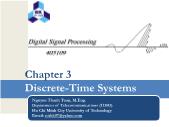 Digital Signal processing - Chapter 3: Discrete - Time systems
Digital Signal processing - Chapter 3: Discrete - Time systemsVẽ sơ đồ khối thực hiện các hệ thống rời rạc sau: 1) y(n) = x(n) + 2x(n – 1) – 3x(n – 3). 2) y(n) = 2x(n – 1) + y(n – 1). 3) y(n) = x(n – 1) + 2y(n – 1). 4) y(n) = x(n – 1) + y(n – 1)/2. 5) y(n) = y(n – 1) – y(n – 2). 6) y(n) = x(n – 1) – y(n – 2). 7) y(n) = x(n – 2) – y(n – 2). 8) y(n) = x(n – 2) – y(n – 1). 9) y(n) = 2x(n) – y(n – 2). 1...
 49 trang | Chia sẻ: nguyenlam99 | Ngày: 22/01/2019 | Lượt xem: 1136 | Lượt tải: 0
49 trang | Chia sẻ: nguyenlam99 | Ngày: 22/01/2019 | Lượt xem: 1136 | Lượt tải: 0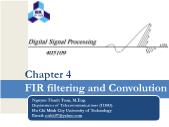 Digital Signal processing - Chapter 4: Fir filtering and convolution
Digital Signal processing - Chapter 4: Fir filtering and convolutionCompute the convolution, y = h ∗ x, of the filter and input, h(n) = {1, -1, -1, 1} , x(n) = {1, 2, 3, 4, @, -3, 2, -1} using the following methods: 1. The convolution table. 2. The LTI form of convolution, arranging the computations in a table form. 3. The overlap-add method of block convolution with length-3 input blocks. 4. The overlap-ad...
 32 trang | Chia sẻ: nguyenlam99 | Ngày: 22/01/2019 | Lượt xem: 661 | Lượt tải: 0
32 trang | Chia sẻ: nguyenlam99 | Ngày: 22/01/2019 | Lượt xem: 661 | Lượt tải: 0


